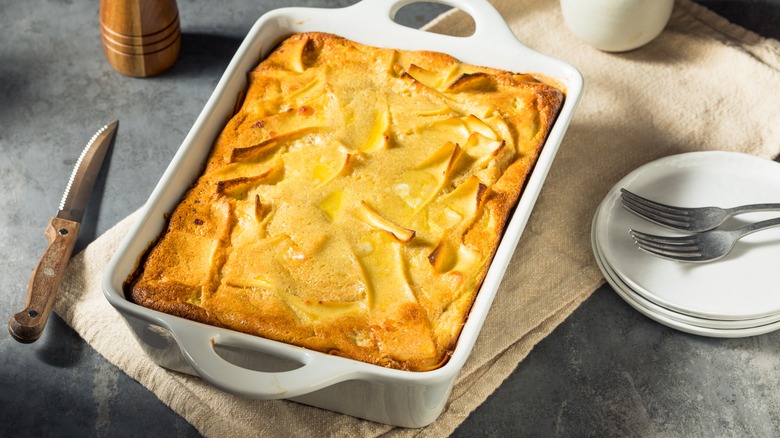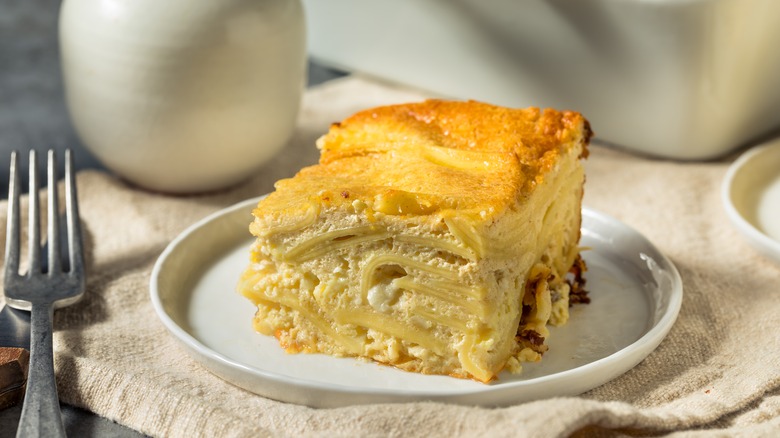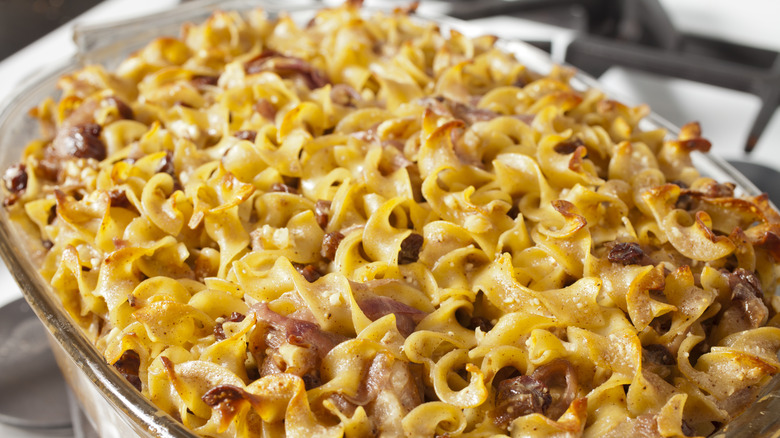The Debated Origin Of Noodle Kugel
As Gil Marks, author of the "Encyclopedia of Jewish Foods," put it, "To know a community is to know its food." While this is true of any community, if you've ever had the supreme pleasure of biting into a soft latke, plush babka, or tangy gefilte fish, then you know what a special pocket of the culinary world Jewish food is. Today, we're deep-diving into one particularly popular traditional Jewish dish with a long history behind it. There's potato kugel, challah kugel, zucchini kugel, and more. But we're talking about arguably the most popular kind — noodle kugel — and its tangled-up origin story.
Noodle kugel (KOO-gull) is a casserole-like baked pudding made from egg noodles. The binding agent is a thick, creamy dairy product, like cottage cheese, cream cheese, sour cream, eggs, butter, or even labneh. Kugel is commonly eaten on Shabbat and enjoyed on special occasions like Rosh Hashanah and Seder. During the Passover feast, many Jewish home cooks alter their recipes to use gluten-free egg noodles to avoid wheat, which is off-limits. The Jewish Talmud says that Shabbat should be "a day of delight," which is where this decadent, noodle-y dish comes in. Plus, since kugel carries a long tradition of enjoyment in recognition of the holy day, enjoying the dish is also a way to honor the past and future. But specifics about the dish's past are murky at best.
A cultural contention
Noodle kugel is traditionally an Ashkenazi dish, a sect of the Jewish community. But, according to Atlas Obscura, before noodles even entered the picture, the earliest forms of kugel were closer to what modern foodies think of as fruitcake. Needless to say, the dish has evolved pretty significantly since then. Noodle (aka lokshen or frimsel) kugel has been around since the 1500s when Jews traveling from Italy to the France-Germany region brought noodles with them. But, around 200 years later, the Tatars (a Turkish-speaking people from West-Central Russia) brought noodles from Asia to Slovakia in Eastern Europe. So, where did noodle kugel officially originate? Sources don't know for sure. In fact, different Yiddish words for the dish derive from different countries' etymologies. The Easter Yiddish lokshen can be traced to the Persian lakhsha and the Western Yiddish frimsel comes from the same Latin root word as vermicelli in Italian.
But, perhaps these differences only serve to illustrate the formidable power of food to unite. As the 1900s rolled around and large Jewish populations from Hungary and Poland immigrated en masse to the U.S., noodle kugel came with them. From 1901-1910, over two million Jewish immigrants came from Europe to America. That's a lot of kugel fans, and unsurprisingly, It didn't take long for the dish to catch on in a big way. Still, though, noodle kugel was further divided — this time by taste.
A dessert? Or an entrée?
Foodies, get excited (or, perhaps, pick a side) — there are sweet and savory versions of noodle kugel. In the sweet version, cinnamon, nutmeg, raisins, and berries intermingle for a sweet casserole-like dessert. It didn't emerge until the 1800s when beet sugar was commonly available in Eastern Europe. After this, Polish and Hungarian noodle kugel departed into the dessert realm and never looked back, though many savory noodle kugel fans remained steadfast. Lithuanian and Russian Jews stuck with an austere salt-and-pepper version. This is in contrast to Isreal's spicy-sweet Yerushalmi noodle kugel, which combines both versions; it's flavored with both caramelized sugar and pepper. (It turns out you can have your kugel and eat it too.)
At the start of the 1900s, America was home to the third-largest Jewish population in the world. According to Atlas Obscura, in the early 20th century, many Jews were focused on assimilating into American culture, causing a decline in the popularity of noodle kugel. However, after WWII, there was a renewed interest in their heritage, and kugel has remained a staple dish on the Shabbat table ever since. Many foods of the mid-century, like cornflakes, maraschino cherries, canned pineapple, and fruit cocktails, found their way into the mix over time — a true fusion of generations and cultures.


